Computerized 3-D images with spectral domain OCT technology can help diagnose glaucoma
A new technique to detect glaucoma is possible by imaging the optic disc and surrounding retina with the computerized 3-D imagery available on the newer spectral domain optical coherence tomography units.
Computerized 3-D imagery can show the elevation of the optic disc rims and the height of the peripapillary retinal nerve fiber layer. Glaucomatous changes in these structures are seen as either a decrease in the optic disc neuro rim height or a thinning of the retinal nerve fiber layer (RNFL) and ganglion cell layer (GCL).
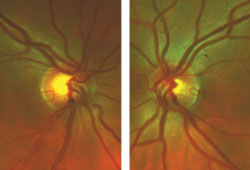 This 62-year-old female was sent in for evaluation due to large optic disc cupping. Her visual acuity was 20/25 (20/20 with pinhole) OD and 20/20- (20/20 with pinhole) OS. Her IOPs were 22 mm Hg OD and 23 mm Hg OS. Her pupils were 3.5 mm, round, 4+ reactive, with no afferent pupillary defect. She had cupping of 0.45 OD and 0.2 OS as viewed with the Digital High Mag lens (Volk). She had asymmetric optic disc sizes with optic disc cupping OD greater than OS as shown by Panoramic 200C images (Optos). Images: Jones W |
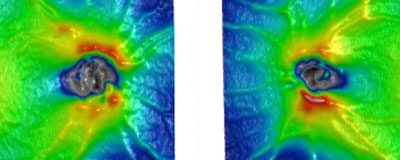 A significant amount of retinal nerve fiber layer (RNFL) in this patient is represented as green grass lands, as shown with the Cirrus HD-OCT (Carl Zeiss Meditec). Yellow to red areas around the disc are caused by elevation of the nerve fiber layer due to underlying blood vessels. |
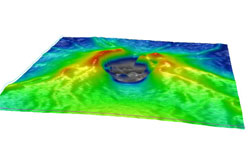 The patient's 3-D disc thickness cube of the right eye showed the superior and inferior disc rims as elevations from green to yellow to red. These are healthy rims. This view is from temporal to nasal (front to back). |
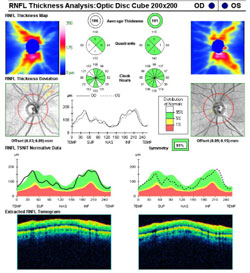 RNFL scans show retinal nerve fiber thickness in the green and white with a high degree of symmetry, at 91%. |
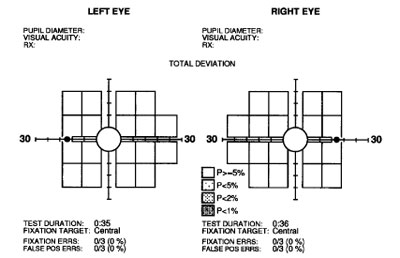 A Matrix N-30-5 FDT screening test in this 62-year-old female showed no defects. |
OCT has greatly added to our ability to diagnose and understand glaucoma. So far, scanning laser studies of the optic nerve head have been performed to determine the topography as it relates to the disc area, rim area and cup volume. Soon thereafter, circular scans were employed at a set distance from the optic disc to measure the RNFL thickness. Both of these techniques were able to uncover early cases of glaucoma better than visual field testing or direct optic nerve head observations.
Advances in posterior segment imaging technology are providing structural data that can be used to detect and monitor glaucomatous damage. OCT has the capability of detecting changes in ocular tissue thickness in the micrometer scale of sensitivity. RNFL thickness evaluation can provide information on early to minimal loss of optic nerve axons that may not be found by other techniques.
Glaucoma and RNFL thickness
It is known that glaucoma is responsible for the loss of both ganglion cells and their axons, thus leading to a decrease in RNFL thickness. The loss of RNFL and the decrease in the dimensions of the neuro rim of the optic disc have been associated with both the existence and progression of glaucoma. Quigley and colleagues have determined that a patient may need to lose up to half of his or her ganglion cells before perimetry tests detect a permanent visual field defect.
RNFL thickness determination in early glaucomatous changes in patients with normal appearing optic discs and normal visual fields is often useful. Spectral domain OCT provides more sensitive circumpapillary RNFL measurements than time domain OCT.
RNFL loss may precede the development of glaucomatous optic neuropathy or visual field loss. Many studies have determined that retinal nerve fiber damage precedes functional loss by as much as 5 years. Recent studies have shown that measures of optic disc and RNFL using optical imaging instruments can predict standard automated perimetric defects in glaucoma suspects with no visual field damage at baseline.
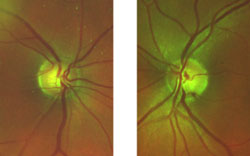 A 50-year-old female was sent in for evaluation due to large optic disc cupping. Her visual acuity was 20/25 OD and 20/20 OS. IOP was 20 mm Hg OD and 22 mm Hg OS. Her pupils were 4 mm OD and 4.25 mm OS, round and 4+ reactive with no afferent pupillary defect. Cupping was 0.7 V x 0.35 H cup OD and 0.4 V x 0.35 H cup OS with a disc margin heme inferior temporal in the left disc as viewed with the Digital High Mag lens. Asymmetric cupping was OD greater than OS with a Drance disc margin hemorrhage at 5 o'clock on the left disc as shown with Panoramic 200C images. |
 This patient's OCT showed green grass lands with inferior temporal blue river and an early superior temporal light blue river distal in the right eye with dark blue and an inferior temporal light blue in the left eye. The left disc shows a small inferior notch of the cup. Orange elevations are caused by blood vessels in the nerve fiber layer around the discs. |
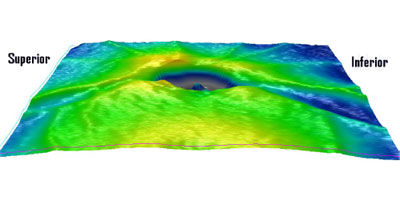 Note the inferior temporal blue river and early superior temporal light blue river in this patient. Also note that the disc margin rim is thin on the superior and inferior regions (inferior greater than superior). The view is from temporal to nasal (front to back). |
 The patient's RNFL analysis showed inferior nerve fiber layer OD greater than OS. The RNFL thickness is marginal at a Smax of 117 µm OD and good at a Smax of 155 µm OS, with a poor Imax of 108 µm OD and good Imax at 150 µm OS. Average thickness is good at 87.61 µm OD and 97.18 µm OS. |
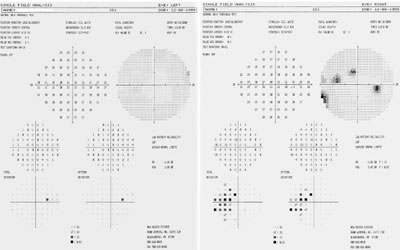 Automated bowl visual fields in this 50-year-old showed nerve fiber bundle defect and inferior nasal step in the right eye and only one small defect in the left eye (which is superior and matches the light blue inferior river). |
Good correlation exists between peripapillary RNFL thickness measured by OCT and visual function as well as histological measurements of RNFL thickness. At this time, the discriminating power of these instruments is limited to the wide range of norms in the RNFL normative data base and the technological assumptions.
RNFL testing may be useful in evaluating patients with small optic nerve heads and tilted discs, because optic disc topography is rather insensitive to retinal nerve fiber loss in such eyes.
An inherent problem with the circular scans of the RNFL is that the samples are thin strips of the RNFL (circular scans were employed at a set distance of 3.45 mm in diameter) and indicate only where the defect is located by quadrants or hour sectors (superior, inferior). The thickness of the RNFL is reported in microns (µm), and the degree of nerve fiber loss is determined by comparison to a normative data base.
Nerve fiber layer loss may occur outside or at the margin of the circle and, thus, may provide measurements that do not fully represent the defect. Also, the data from the RNFL circle reveals little about the total appearance and location of the defect in the RNFL.
Matching field defects to RNFL loss
It has always been perplexing to understand the variety of visual field defects found in glaucoma patients. Why the difference?
It is important to know the size and shape of RNFL loss to match it to the visual field defects and RNFL circular scan results. The shape and location of the RNFL loss allows a better understanding of why different visual field defects are seen in glaucoma.
RNFL loss with this new technique explains why the visual field defects are different in my glaucoma patients. At times you see only a few grouped nonadjacent spots on the field and wonder if they truly represent a subtle glaucomatous defect. I have found that if they are in the region expected to be present considering the RNFL defect with this technique, I am much more assured that it is an early defect due to glaucoma.
Recent reports claim that RNFL loss and visual field results do not always agree. I have often found that the RNFL loss may appear to be significant, but visual field defects are rather minor. This may be due to fact that there is an abundance of nerve fiber and it requires a large number of the nerve fibers to be lost before the visual field can manifest a detectable defect.
 This 46-year-old female was a glaucoma suspect because her sister and daughter had ocular hypertension. Her IOPs were 29 mm Hg OS. Pupils were 4 mm, round and 4+ reactive, with negative afferent pupillary defect. Cupping was 0.9 V x 0.65 H cup OD and 0.8 V x 0.65 H OS shallow excavations viewed with the Digital High Mag lens. Large optic disc cupping (pallor OS greater than OD) could be seen with Panoramic 200C images. |
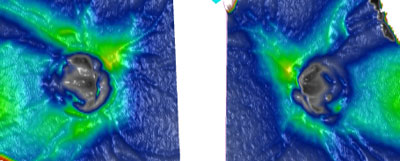 The patient's OCT showed inferior temporal green grassland with superior temporal blue river in the right eye and loss of green grassland with large superior temporal blue to light gray river and less developed inferior temporal blue river in the left eye. There appears to be an inferior temporal disc margin notch in the left eye. |
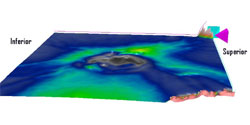 The superior blue river is larger than the inferior blue river in this patient's left eye. Because there has been an extensive overall loss of RNFL, the plane of the retina looks flat with just a few small areas of slight elevation (likely due to blood vessels in the RNFL). The loss of elevation from the blood vessels is likely due to the loss in thickness of the ganglion cell layers and RNFL, resulting in a decrease in vessel height. There is no neuro rim to the optic disc. The irregular pink area is due to the image not being scanned in that corner (cut-off view). This view is from temporal to nasal (front to back). |
 This 46-year-old female's RNFL analysis showed marked loss of the nerve fiber layer in the left eye (inferior greater than superior) and early loss in the right eye. The RNFL thickness is good at a Smax of 141 µm and marginal Imax of 124 µm OD and a marginal Smax of 124 µm and a poor Imax of 87 µm OS. The average thickness is good at 91.77 µm OD and poor at 74.08 µm OS. |
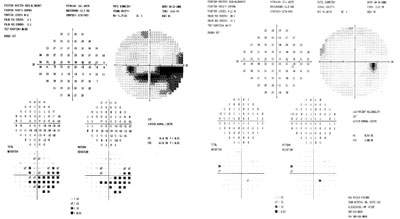 This patient's automated bowl visual fields show mild central defects in the right eye. The left eye shows an inferior nerve fiber bundle defect that agrees with the superior broad blue to gray river and milder superior defects that match the less developed inferior blue river. |
At this time, the progression of glaucoma as measured by OCT and visual fields is not a one-to-one effect, and there may be a moderate correlation with visual field defects in early visual field loss and far less with advanced RNFL loss.
Another important benefit of assessing the RNFL loss pattern is that it points to the location on the optic disc where more cupping, increased pallor or a rim notch will be found. I have had subtle cases of normal tension glaucoma in which the shallow excavation was barely visible, even with enhanced stereopsis during a slit lamp examination with a Digital High Mag (Volk) lens. It would have been easy to overlook such a small change in optic disc cupping. No telling how many cases are missed without using the new technologies.
Point-by-point image
This method of computerized 3-D imagery is essentially a point-by-point determination of the retinal thickness collected within the entire data cube. To be able to produce such a data image, it requires a scanning device that is able to collect a massive amount of data that can then analyzed by the computer and displayed in a point-by-point image. It must be relatively fast at collecting this large amount of data so movement artifacts are minimized. Also, fast collection is necessary to obtain patient cooperation during the testing event.
Such 3-D imagery requires a reference point to determine relative distance calculations. The reference point/points (plane) must be easily found by the instrument, and highly reflective interfaces are ideal for such determinations.
The two best reflective interfaces in OCT scanning are the internal limiting membrane (ILM) and the retinal pigment epithelium (RPE). The distance from the ILM to the RPE can be easily determined by OCT, and any depression in the retinal surface or elevation in the RPE will be displayed as a 3-D depression in the displayed scan block. Therefore, a loss of GCL and RNFL is seen as a depression in the top layer of the scan block.
Because the loss of both the GCL and RNFL results in a thinning of the scan block, the displayed cube scan will demonstrate this as a depression in the anterior surface of the displayed image or what would be a depression in the RNFL. If there is an elevation in the RPE or if something in the sensory retina is highly reflective, the instrument determines a decreased distance between the ILM and RPE and again represents it as depression in the surface of the scan block.
If the ILM or RPE are individually used as a reference plane, and a reflective source is detected outside that plane of reference, it is represented as either above or below that layer. As an example of this effect, a significantly elevated drusen will be seen as a depression in the surface of retinal thickness scan block but as an elevation in the RPE layer and no change in the ILM layer (unless it is a very elevated soft drusen).
The relative distances between the two reference points (plane) have been given a color code system. Zero microns (µm) is black, 100 µm ranges from dark gray to light gray, 200 µm ranges from light blue to dark blue, 300 µm ranges from light green to dark green, 400 µm ranges from yellow/orange to light red, 500 µm is red, and greater than 500 µm is white.
A direct comparison
The 3-D imagery method allows a direct comparison of the RNFL/GCL over the total anterior surface of the cube because of the point-by-point determination of the RNFL/GCL thickness. The loss of RNFL/GCL is displayed as a color change and, thus, an area of loss is seen as a darker color as compared to RNFL/GCL thicknesses across the entire anterior surface of the cube. This is of great value, for the change in color determines the presence of RNFL/GCL loss due to glaucoma as it compares to the RNFL/GCL in all other areas of the image. Therefore, it is a direct comparison of RNFL/GCL change, and a normative data base for comparison is not required. The instrument is measuring self against self.
In glaucoma, the decrease in height of the retina in the cube represents both the loss of the RNFL and GCL (ganglion cell and nerve fiber are lost at essentially the same time). Therefore, reference to RNFL changes with this technique represents both the RNFL and GCL.
There has been discussion of the importance of GCL loss in diagnosing glaucoma and retinal diseases. This technique allows a determination of the loss of both layers as seen as an overall decrease in retinal thickness, which I believe to be an advantage over determining the thickness of each layer individually. The percentage of loss is likely to be greater when both layers are considered as a unit of loss, as compared to determining one layer at a time.
Because the 3-D disc scan shows the superior and inferior surface (if you evert the image), the data provided by the initial presentation of the cube is of the anterior surface and, thus, represents the RNFL and GCL having less height. In cases of moderate and early advanced glaucoma, the green is gone and replaced with blue and gray, indicating thinning of RNFL/GCL layers, and only green showing is due to the elevation of the major retinal vessels in these layers. This indicates that the RNFL is being draped between the retinal major retinal vessels and that the small vessels branching off of the major vessels are being redirected in a posterior direction.
 This 46-year-old male was a glaucoma suspect due to high IOPs of 23 mm Hg OD and 35 mm Hg OS. Visual acuity is 20/50 (20/20 with pinhole) OD and 20/40 (20/80 with pinhole) OS. Pupils were 3.5 mm, round and 4+ reactive in the right eye and 1+ to 2+ reactive in the left eye with 2+ afferent pupillary defect. Cupping was 0.35 OD and 0.9 OS viewed with the Digital High Mag lens. Asymmetric cupping was greater in the left eye than the right as viewed by Panoramic 200C images. |
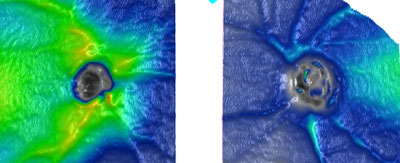 This patient's right eye has a lot of green grassland (except for a small area of blue inferior), and the left eye has lost most of the green grassland (except for a temporal island of light green). |
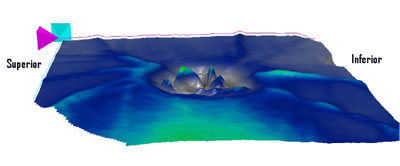 Note the loss of the optic disc neuro rim for 360 degrees in this 46-year-old male. The only grassland remaining is seen as a light green temporal island. This view is from temporal to nasal (front to back). |
 This 46-year-old female's RNFL analysis showed marked loss of the nerve fiber layer in the left eye (inferior greater than superior) and early loss in the right eye. The RNFL thickness is good at a Smax of 141 µm and marginal Imax of 124 µm OD and a marginal Smax of 124 µm and a poor Imax of 87 µm OS. The average thickness is good at 91.77 µm OD and poor at 74.08 µm OS. |
 The automated bowl visual fields showed a marked constriction in the left eye; the right eye is without defects. |
This begs the question: does the posterior redirection of blood flow in these small vessels lead to further atrophy of the nerve fiber layer neurons? Is there another form of vascular problem that is involved in the loss of RNFL?
These small differences in distances are very much enhanced on the 3-D data cube. Therefore, even a slight elevation is pronounced on the displayed image. The optic disc rim margin is only about 50 µm to 100 µm above the surface of the disc but is seen as a definite raised margin on the data thickness cube. This enhancement is important, for it allows one to easily see loss of rim margin, which is critical in diagnosing glaucomatous optic atrophy. The enhanced distance determination is also critical for the RNFL/GCL loss or elevation (thickness).
Green grasslands, blue rivers
Normally, the height of the RNFL from the RPE is in the green (300 µm), and a small loss of RNFL is then easily seen as a light to dark blue, and marked loss is seen as gray. This allows for a fast observation of the image to determine the possibility of RNFL loss. In describing this loss of RNFL thickness to patients, I explain normal as “green grassland,” mild to moderate loss as “blue rivers” and advanced loss as gray “glacier rivers.”
When determining the presence of glaucoma (RNFL/GCL loss), one should carefully look for asymmetry of the green grasslands. Even subtle asymmetry may indicate RNFL/GCL loss, and marked asymmetry is usually a strong indication of the presence of glaucoma. Not all RNFL/GCL loss is due to glaucoma but can be seen in other causes of retinal degeneration and dystrophy such as high myopia and post-traumatic retinal degeneration.
Visual field defects can be explained by the pattern of RNFL loss. Blue rivers in the green grasslands represent nerve fiber bundle defect (Bjerrum scotoma) on visual field testing. Loss of RNFL principally superior or inferior to the optic disc is seen as a superior or inferior altitudinal-like loss on visual fields. If the loss is both above and below the disc, it will show as a 360-degree or nearly 360-degree constriction of the visual field.
This method of RNFL display allows one to understand why the visual filed defect has such a pattern in each case of glaucoma. There may significant loss of retinal thickness in the posterior pole of up to 34% in patients with early glaucoma. I have noted that it requires a large amount of green grassland loss before significant repeatable visual field defects are found.
Diagnosing glaucoma or the absence of glaucoma has become much easier using this 3-D disc method. I have been amazed how definitive my diagnoses have become.
As we all know, it is much more difficult to diagnose glaucoma than it is to treat it in most cases. There is little difficulty in determining the existence of moderate neural rim loss on stereoscopic viewing, but such observations with early glaucoma are much more equivocal.
We as clinicians tend to be careful not to inform patients that they may or may not have glaucoma until we are sure, due to the fear and anxiety that patients harbor when they hear the term glaucoma. I have found that the ability to diagnose normal-tension glaucoma is much easier and more accurate with this method. I must admit that having the visual fields match the RNFL findings makes me much more confident about my diagnoses.
Nonstandard image capture
The 3-D images in this article were produced by the spectral domain Cirrus HD-OCT (Carl Zeiss Meditec). It has a scan speed of 27,000 A-scans per second, with an axial resolution of 5 u, a transverse resolution of 15 u and a scan depth of 2 mm with 1,024 data points, and the macular cube 512 x 128 combo has 200 horizontal line scans comprising 512 A-scans each.
The capture method chosen for the 3-D disc is the macular cube scan. This scan is able to create a thickness map of the tissue from the ILM to the RPE in the macular area.
My method is not a standard application of the instrument but can be easily performed. After obtaining the best view of the macular area by centering the scan in the pupil and obtaining the best focus (maximum clarity), click on the bisected aiming cube square and drag it a small distance away from the small green aiming target cross. Then click on the small green cross and drag it laterally to place the optic disc in the central area of the viewing screen.
Next, click and drag the aiming square over the disc so the crosshairs are bisecting it. Adjust the height of the OCT line scans in the lower scan windows so they are not too high (ends of the scans do not disappear or are being reflected downward). Trigger an image capture and analyze it for both quality and position. If the ends of the inferior line scans are too high in their respective windows, it will result in loss of data on the edges of scan cube presentation (areas will be ragged and will be missing or appear black). A blink will appear as a horizontal line of image distortion and eye movements will be seen as lateral displacement of the optic disc sections or areas.
The accompanying cases and images show how this 3-D technology is able to assist in the diagnoses that vary from a glaucoma suspect to an early glaucoma case to a moderate case and, lastly, to an advanced case.
References:
- Airaksinen PJ, Drance SM, Douglas GR, et al. Diffuse and localized nerve fiber loss in glaucoma. Am J Ophthalmol. 1984;98:556-571.
- Anton A, Zangwill L, Weinreb RN, et al. Nerve fiber layer measurements with scanning laser polarimetry in ocular hypertension. Am J Ophthalmol. 1997;115:331-334.
- Bowd C, Weinreb RN, Williams JM, et al. The nerve fiber layer thickness in ocular hypertensive, normal and glaucomatous eyes with optical coherence tomography. Arch Ophthalmol. 2000;118:22-26.
- Bowd C, Zangwill L, Berry CC, et al. Detecting early glaucoma by assessment of retinal nerve fiber layer thickness and visual function. Invest Ophthalmol Vis Sci. 2001;42:1993-2003.
- Bowd C, Zangwill L, Medeiros, et al. Confocal scanning laser ophthalmoscopy classifiers and stereographic evaluation for prediction of visual field abnormalities in glaucoma-suspect eyes. Invest Ophthalmol Vis Sci. 2004;45:2255-2262.
- Caprioli J. Contour of the juxtapapillary retinal nerve fiber layer in glaucoma. Ophthalmology. 1990;97:358-365.
- Caprioli J, Miller JM. Measurements of peripapillary nerve fiber layer surface height in glaucoma. Ophthalmology. 1989;96:633-639.
- Caprioli J, Ortiz-Goldberg R, Miller JM, et al. Measurements of peripapillary nerve fiber layer contour in glaucoma. Am J Ophthalmol. 1989;108:404-413.
- Caprioli J, Park JH, Ugurlu S, Hoffman D. Slope of the peripapillary nerve fiber layer surface in glaucoma. Invest Ophthalmol Vis Sci. 1998;38:2321-2328.
- Drance SM. The disc and the field of glaucoma. Ophthalmology. 1978;85:209-214.
- Dreher AW, Reiter K, Weinreb RN. Spatially resolved birefringence of the retinal nerve fiber layer assessment with retinal ellipsometer. Appl Opt. 1995;31:2330-3735.
- Eid TM, Speath GL, Azuara-Blanco A, et al. Quantitative estimation of retinal nerve fiber layer height in glaucoma and the relationship with optic nerve head topography and visual field. J Glaucoma. 1997;6:221-230.
- Fechtner RD, Weinreb RN. Mechanisms of optic nerve damage in primary open-angle glaucoma. Surv Ophthalmol.1994;39:23-42.
- Fugjimoto JG, Bouma B, Tearney GJ, et al. New technology for high-speed and high-resolution optical coherence tomography. Ann NY Acad Sci. 1998;838:95-107.
- Greenfield DS, Bagga H, Knighton RW. Macular thickness changes in glaucomatous optic neuropathy detected using optical coherence tomography. Arch Ophthalmol. 2003;121:41-46.
- Greenfield DS, Huang X-R, Knighton RW. Effect of corneal polarization axis on assessment of retinal nerve fiber layer thickness by scanning laser polarimetry. Am J Ophthalmol. 2000;129:715-722.
- Greenfield DS, Knighton RW. Stability of corneal polarization axis measurements for scanning laser polarimetry. Ophthalmology. 2001;108:1065-1069.
- Harwerth RS, Carter-Dawson L, Shen F, et al. Ganglion cell loss underlying visual field defects from experimental glaucoma. Invest Ophthalmol Vis Sci. 1999;40:2242-2250.
- Hasson M. RNFL thickness deviation map enhances assessment of glaucoma progression. Ocular Surgery News. 2010;28(23):6.
- Hernandez MR, Pena JDO. The optic nerve head in glaucomatous optic neuropathy. Arch Ophthalmol. 1997;115:389-395.
- Hoh ST, Greenfield DS, Mistlburger A, et al. Relationship of optical coherence tomography and scanning laser polarimetry in normal, ocular hypertension and glaucomatous eyes. Ophthalmology. 2000;129:129-135.
- Hoyt WF, Frisen L, Newman NM. Funduscopy of nerve fiber layer defect in glaucoma. Invest Ophthalmol Vis Sci. 1973;12:814-829.
- Hoyt WF, Newman NM. The earliest observable defect in glaucoma. Lancet.1972;1:692-693.
- Huang Y, Cideciyan AV, Papastergiou GI, et al. Relationship of optical coherence tomography to microanatomy in normal and rd chickens. Invest Ophthalmol Vis Sci. 1998;39:2405-2416.
- Huang D, Swanson EA, et al. Ocular coherence tomography. Science. 1991;254:1178-1181.
- Izatt JA, Hee MR, Swanson EA, et al. Micrometer-scale resolution imaging of the anterior eye in vivo with optical coherence tomography. Arch Ophthalmol. 1994;112:1584-1489.
- Johnson CA, Sample PA, Zangwill L, et al. Structure and function evaluation (SAFE). II: comparison of optic disc and visual field characteristics. Am J Ophthalmol. 2003;135:148-154.
- Medeiros FA. Structural, functional evaluation methods essential for detecting glaucomatous changes. Primary Care Optometry News. 2010;15:8.
- Mistlburger A, Leiberman JM, Greenfield DS, et al. Heidelberg retinal tomography and optical coherence tomography in normal, ocular hypertensive and glaucomatous eyes. Ophthalmology. 1999;106:2027-2032.
- Mohammad K, Bowd C, Weinreb RN, et al. Retinal nerve fiber layer thickness measurements with scanning laser polarimetry predicts glaucomatous visual field loss. Am J Ophthalmol. 2004;138:592-601.
- Neuville J. Visual field, OCT results show poor correlation in advanced RNFL loss. Primary Care Optometry News. 2011;16:8.
- Pieroth L, Schuman JS, Hertzmark E, et al. Evaluation of local defects in the nerve fiber layer using ocular coherence tomography. Ophthalmology. 1999;106:570-579.
- Quigley HA. Better methods in glaucoma diagnosis. Arch Ophthalmol. 1985;103:185-189.
- Quigley HA. Diagnosing early glaucoma with nerve fiber layer examination. New York, NY:Igau-Shoin; 1996.
- Quigley HA. Examination of the nerve fiber layer in the recognition of early glaucoma damage. Trans Am Ophthalmol Soc. 1986;84:920-966.
- Quigley HA, Addicks EM. Quantitative studies of nerve fiber defects. Arch Ophthalmol. 1982;100:807-814.
- Quigley HA, Addicks EM, Green WR. Optic nerve damage in human glaucoma. III. Quantitative correlation of nerve fiber loss and visual field defects in glaucoma, ischemic optic neuropathy, papilledema and toxic optic neuropathy. Arch Ophthalmol. 1982;100:135-146.
- Quigley HA, Dunkelburger GR, Green WR. Retinal ganglion cell atrophy correlated with automated perimetry in human eyes with glaucoma. Am J Ophthalmol. 1989;107:453-464.
- Quigley HA, Miller NR, George T. Clinical evaluation of nerve fiber layer atrophy as an indicator of glaucoma. Arch Ophthalmol. 1980;98:1564-1571.
- Quigley HA, Katz J, Derick RJ, et al. An evaluation of optic disc and nerve fiber layer examination in monitoring progression of early glaucoma damage. Ophthalmology. 1992;99:19-28.
- Schuman JS, Hee MR, Puliafito CA, et al. Quantification of nerve fiber layer thickness in normal and glaucomatous eyes using optical coherence tomography. Ophthalmology. 1995;113:586-596.
- Sommer A, Katz J, Quigley HA, et al. Clinically detectable nerve fiber layer atrophy precedes the onset of glaucoma. Arch Ophthalmol. 1991;109:77-83.
- Sommer A, Miller NR, Pollack I, et al. The nerve fiber layer in the diagnosis of glaucoma. Arch Ophthalmol. 1977;95:2149-2146.
- Sommer A, Quigley HA, Robin AL, et al. Evaluation of nerve fiber layer assessment. Arch Ophthalmol. 1964;102:1766-1771.
- Tjo-Fo-Sang MJ, de Vries J, Lemij HG. Measurement by nerve fiber analyzer of the retinal nerve fiber layer thickness in normal subjects and patients with ocular hypertension. Am J Ophthalmol. 1996;122:220-227.
- Truble JR, Schultz RO, Robinson JC, et al. Accuracy of scanning laser polarimetry in the diagnosis of glaucoma. Arch Ophthalmol. 1999;117:1298-1304.
- Tuulonen A, Airaksinen PJ. Initial glaucomatous optic disc and retinal nerve fiber layer abnormalities and their progression. Am J Ophthalmol. 1991;111:485-490.
- Tuulonen A, Lethola Airaksinen PJ. Nerve fiber layer defects with normal visual fields: do normal optic disc and normal visual fields indicate absence of glaucomatous abnormality? Ophthalmology. 1993;100:586-598.
- Weinreb RN. Assessment of the optic disc topography for diagnosing and monitoring glaucoma. Arch Ophthalmol. 1998;116:1229-1231.
- Weinreb RN. Evaluating the nerve fiber layer in glaucoma with scanning laser polarimetry. Arch Ophthalmol. 1999;117:1403-1406.
- Weinreb RN, Dreher AW, Bille JF. Quantitative assessment of the optic nerve head with laser tomographic scanner. Int Ophthalmol.1989;13:25-29.
- Weinreb RN, Schakiba S, Zangwill L. Scanning laser polarimetry to measure the nerve fiber layer of normal and glaucomatous eyes. Arch Ophthalmol. 1994;119:627-636.
- Zangwill L, Berry CC, Bathija PA, et al. Detection of early to moderate glaucomatous damage with the nerve fiber analyzer (NFA II) (abstract). Invest Ophthalmol Vis Sci. 1998;39:S702. Abstract 3226.
- Zangwill L, Schakiba S, Caprioli J, et al. Agreement between clinicians and a confocal scanning laser ophthalmoscope in the estimating cup-to-disc ratios. Am J Ophthalmol. 1995;119:415-421.
- Zangwill L, Williams J, Berry CC, et al. A comparison of optical coherence tomography and retinal nerve fiber layer photography for detection of nerve fiber damage in glaucoma. Ophthalmology. 2000;107:1309-51315.
- Zeyen TG, Caprioli J. Progression of disc and field damage in early glaucoma. Arch Ophthalmol. 1993;111:62-65.
- William Jones, OD, FAAO, is a member of the Primary Care Optometry News Editorial Board. He can be reached at 1828 Conestoga, SE, Albuquerque, NM 87123; (505) 293-7347; wjones556654@comcast.net.
- Disclosure: Dr. Jones has no financial interest in the products mentioned, but Carl Zeiss Meditec sponsors him for lectures. He is a paid consultant for Optos.

